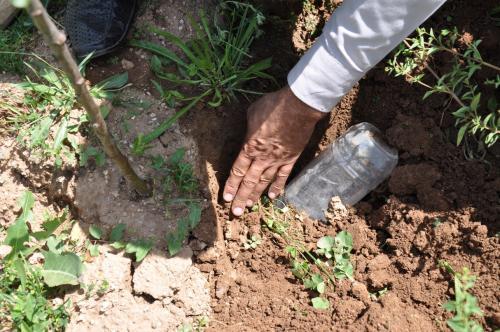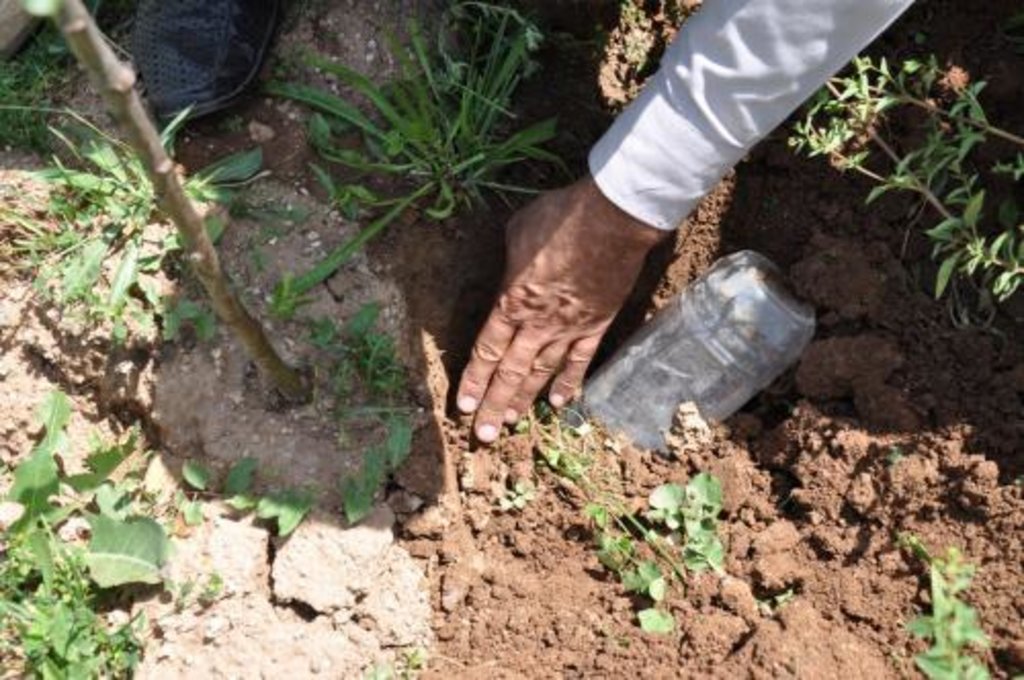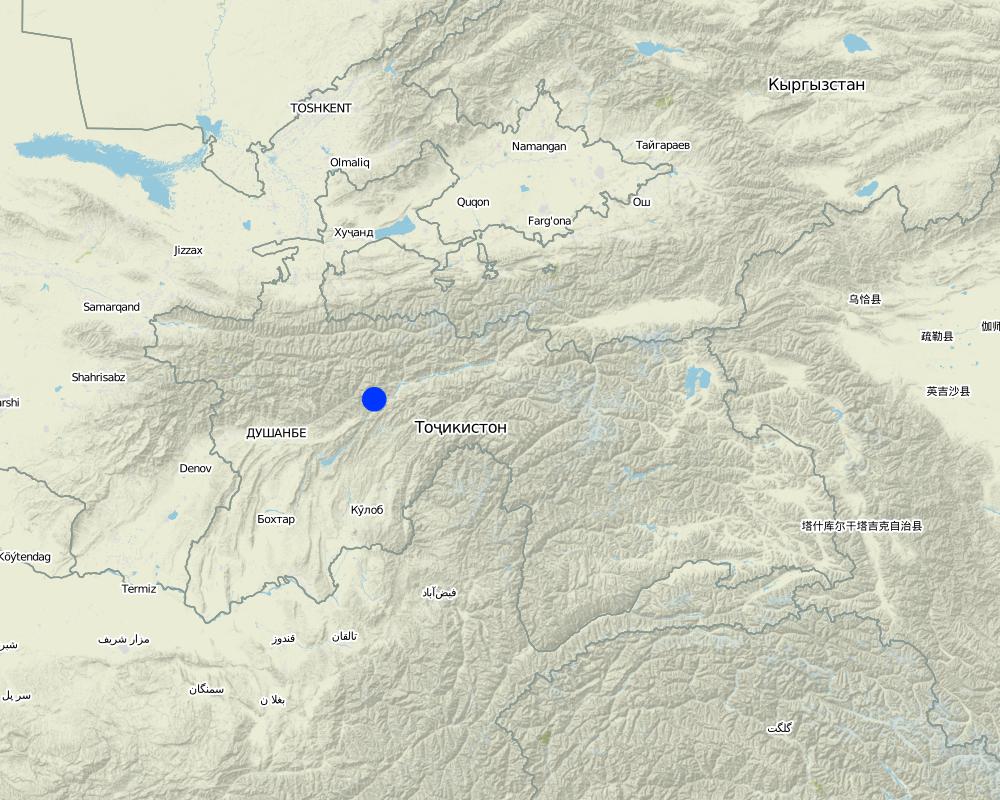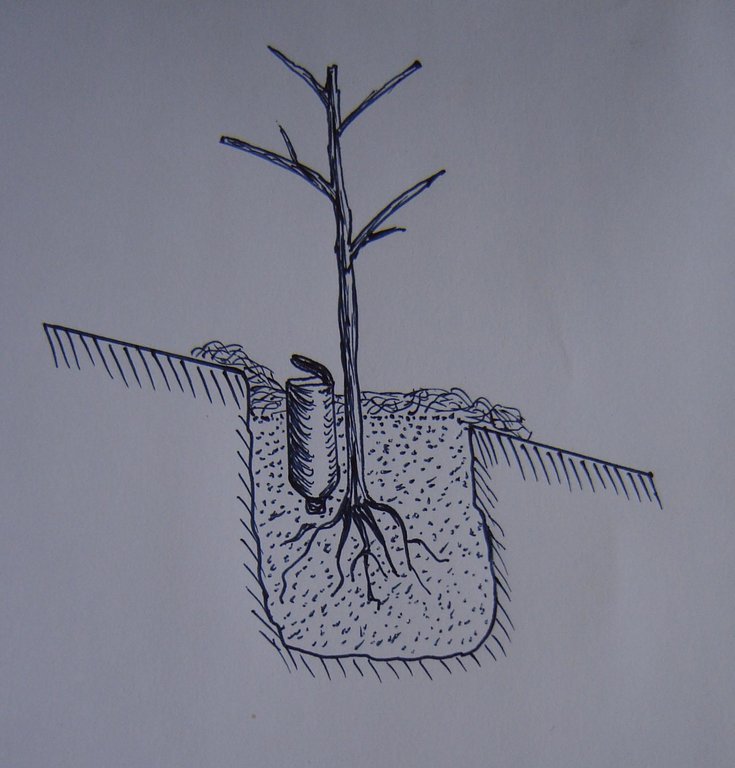Bottle irrigation of a newly planted orchard [Tajikistan]
- Creation:
- Update:
- Compiler: Pjotr M Sosin
- Editor: –
- Reviewers: David Streiff, Alexandra Gavilano
Обёрии катраги ба воситаи зарфхои пласмаси
technologies_1029 - Tajikistan
View sections
Expand all Collapse all1. General information
1.2 Contact details of resource persons and institutions involved in the assessment and documentation of the Technology
Name of the institution(s) which facilitated the documentation/ evaluation of the Technology (if relevant)
Tajik Soil Insitute (Tajik Soil Institute) - Tajikistan1.3 Conditions regarding the use of data documented through WOCAT
The compiler and key resource person(s) accept the conditions regarding the use of data documented through WOCAT:
Yes
2. Description of the SLM Technology
2.1 Short description of the Technology
Definition of the Technology:
A water-saving irrigation technique is used to ensure the establishment of young seedlings in arid conditions which have a water deficit.
2.2 Detailed description of the Technology
Description:
Plastic bottles, 1.5-2 litres in size, are used for this technology. The bottom of the plastic bottle is removed and retained to be used as a cover. The bottle is then turned upside down and filled with water like a funnel. In this position, the lid of the bottle is twisted open very slowly until a drip rate of 5 drops per second is achieved. As soon as the desired water drip rate is reached, the lid is stuck to the bottle with some tape. At this drip rate 1.5 litres of water will drip out of the bottle every 90-100 minutes. The bottle is then buried in the soil next to the seedling with the wide part of the funnel sticking 10cm up out of the ground. The bottle's lid must be buried at the same level as the root collar. After this, grass, straw or black film is used to mulch the soil around the newly planted seedlings. Water drips slowly out and can go straight to the roots. Thus, no watering of the upper layer is needed. This technique also helps exclude evaporation of water from the upper layer of the soil. During the growth period bottles are filled with water once every 5 days. Bottles should be filled with clean water to avoid clogging of the lids.
Purpose of the Technology: The purpose of the technology is to improve the acclimation of seedlings with minimal use of water, as well as to help reduce erosion and risk of mudslides on these steep loess slopes which can occur as a result of other irrigation techniques.
Establishment / maintenance activities and inputs: Selection of a plot, digging holes, purchase of seedlings, fencing nets, plastic bottles, preparation of bottles, planting seedlings, mulching, post-planting care for seedlings, irrigation
Natural / human environment: Middle mountain area, typical mountain brown soil, 30° slopes, rainless dry summer period. Vegetation cover is mainly large-sized cereal semi-savanna. Local population is involved in cattle-breeding and gardening.
2.3 Photos of the Technology
2.5 Country/ region/ locations where the Technology has been applied and which are covered by this assessment
Country:
Tajikistan
Region/ State/ Province:
Tajikistan
Further specification of location:
Nurabad District
Comments:
Total area covered by the SLM Technology is 0.05 km2.
Map
×2.6 Date of implementation
If precise year is not known, indicate approximate date:
- less than 10 years ago (recently)
2.7 Introduction of the Technology
Specify how the Technology was introduced:
- during experiments/ research
3. Classification of the SLM Technology
3.1 Main purpose(s) of the Technology
- reduce, prevent, restore land degradation
3.2 Current land use type(s) where the Technology is applied

Cropland
- Annual cropping
- Tree and shrub cropping
Number of growing seasons per year:
- 1

Grazing land
Extensive grazing:
- Semi-nomadic pastoralism

Forest/ woodlands
Products and services:
- Fuelwood
- Fruits and nuts
Comments:
Major land use problems (compiler’s opinion): Farming can lead to erosion. Steep slopes are prone to mudslides. There is lack of irrigation water. Vegetation cover is severely damaged by extensive grazing.
Semi-nomadism / pastoralism: Yes
Forest products and services: fuelwood, fruits and nuts
Future (final) land use (after implementation of SLM Technology): Cropland: Ct: Tree and shrub cropping
Livestock is grazing on crop residues
3.3 Has land use changed due to the implementation of the Technology?

Cropland
- Tree and shrub cropping

Grazing land
- Livestock density (if relevant): 1-10 LU /km2
3.4 Water supply
Water supply for the land on which the Technology is applied:
- rainfed
Comments:
Потребность в воде: богарное, богарное
3.5 SLM group to which the Technology belongs
- improved ground/ vegetation cover
- irrigation management (incl. water supply, drainage)
3.6 SLM measures comprising the Technology

agronomic measures
- A7: Others

vegetative measures
- V1: Tree and shrub cover

structural measures
- S11: Others

management measures
- M1: Change of land use type
Comments:
Main measures: vegetative measures, structural measures, management measures
Type of agronomic measures: mulching
3.7 Main types of land degradation addressed by the Technology

soil erosion by water
- Wt: loss of topsoil/ surface erosion
- Wg: gully erosion/ gullying
Comments:
Main type of degradation addressed: Wg: gully erosion / gullying
Secondary types of degradation addressed: Wt: loss of topsoil / surface erosion
Main causes of degradation: overgrazing, Heavy / extreme rainfall (intensity/amounts), land tenure
Secondary causes of degradation: over-exploitation of vegetation for domestic use, other natural causes (avalanches, volcanic eruptions, mud flows, highly susceptible natural resources, extreme topography, etc.) specify, population pressure
3.8 Prevention, reduction, or restoration of land degradation
Specify the goal of the Technology with regard to land degradation:
- prevent land degradation
Comments:
Main goals: prevention of land degradation
4. Technical specifications, implementation activities, inputs, and costs
4.1 Technical drawing of the Technology
Technical specifications (related to technical drawing):
Installation of bottle when planting a seedling
Location: Mujiharv Jamoat. Nurabad
Date: 2011.04.05
Technical knowledge required for field staff / advisors: high
Technical knowledge required for land users: moderate
Secondary technical functions: stabilisation of soil (eg by tree roots against land slides), increase / maintain water stored in soil
Author:
Sosin Pjotr, Dushanbe, 21a Rudaki Avenue
4.2 General information regarding the calculation of inputs and costs
Specify currency used for cost calculations:
- USD
4.3 Establishment activities
| Activity | Timing (season) | |
|---|---|---|
| 1. | Purchase of fencing net to fence the plot | 7 days |
| 2. | Purchase of seedlings | 1 month |
| 3. | Planting of seedlings | 10 days |
| 4. | Fencing the plot | 10 days |
4.4 Costs and inputs needed for establishment
| Specify input | Unit | Quantity | Costs per Unit | Total costs per input | % of costs borne by land users | |
|---|---|---|---|---|---|---|
| Labour | Planting of seedlings | pieces | 2000.0 | 0.227 | 454.0 | 100.0 |
| Labour | Fencing the plot | ha | 0.7 | 194.285 | 136.0 | 100.0 |
| Equipment | Fencing net to fence the plot | meters | 100.0 | 28.2 | 2820.0 | |
| Equipment | Plastic bottles | pieces | 2000.0 | 0.0045 | 9.0 | |
| Plant material | Seedlings | pieces | 2000.0 | 1.8865 | 3773.0 | |
| Total costs for establishment of the Technology | 7192.0 | |||||
| Total costs for establishment of the Technology in USD | 7192.0 | |||||
4.5 Maintenance/ recurrent activities
| Activity | Timing/ frequency | |
|---|---|---|
| 1. | Mulching | |
| 2. | Watering | |
| 3. | Plastic bottles |
4.6 Costs and inputs needed for maintenance/ recurrent activities (per year)
| Specify input | Unit | Quantity | Costs per Unit | Total costs per input | % of costs borne by land users | |
|---|---|---|---|---|---|---|
| Labour | Mulching | ha | 1.0 | 454.0 | 454.0 | 100.0 |
| Labour | Watering | ha | 1.0 | 273.0 | 273.0 | 100.0 |
| Labour | Plastic bottles placing | pieces | 2000.0 | 0.023 | 46.0 | 100.0 |
| Total costs for maintenance of the Technology | 773.0 | |||||
| Total costs for maintenance of the Technology in USD | 773.0 | |||||
5. Natural and human environment
5.1 Climate
Annual rainfall
- < 250 mm
- 251-500 mm
- 501-750 mm
- 751-1,000 mm
- 1,001-1,500 mm
- 1,501-2,000 mm
- 2,001-3,000 mm
- 3,001-4,000 mm
- > 4,000 mm
Agro-climatic zone
- semi-arid
Thermal climate class: subtropics
5.2 Topography
Slopes on average:
- flat (0-2%)
- gentle (3-5%)
- moderate (6-10%)
- rolling (11-15%)
- hilly (16-30%)
- steep (31-60%)
- very steep (>60%)
Landforms:
- plateau/plains
- ridges
- mountain slopes
- hill slopes
- footslopes
- valley floors
Altitudinal zone:
- 0-100 m a.s.l.
- 101-500 m a.s.l.
- 501-1,000 m a.s.l.
- 1,001-1,500 m a.s.l.
- 1,501-2,000 m a.s.l.
- 2,001-2,500 m a.s.l.
- 2,501-3,000 m a.s.l.
- 3,001-4,000 m a.s.l.
- > 4,000 m a.s.l.
5.3 Soils
Soil depth on average:
- very shallow (0-20 cm)
- shallow (21-50 cm)
- moderately deep (51-80 cm)
- deep (81-120 cm)
- very deep (> 120 cm)
Soil texture (topsoil):
- medium (loamy, silty)
Topsoil organic matter:
- medium (1-3%)
If available, attach full soil description or specify the available information, e.g. soil type, soil PH/ acidity, Cation Exchange Capacity, nitrogen, salinity etc.
Soil fertility is low
Soil drainage / infiltration is medium
Soil water storage capacity is medium
5.4 Water availability and quality
Ground water table:
> 50 m
Availability of surface water:
medium
Water quality (untreated):
good drinking water
5.5 Biodiversity
Species diversity:
- medium
5.6 Characteristics of land users applying the Technology
Market orientation of production system:
- subsistence (self-supply)
- commercial/ market
Off-farm income:
- 10-50% of all income
Relative level of wealth:
- average
Individuals or groups:
- individual/ household
Level of mechanization:
- animal traction
Gender:
- men
Indicate other relevant characteristics of the land users:
Land users applying the Technology are mainly common / average land users
Difference in the involvement of women and men: Wife takes care about the household (children, food)
Population density: 10-50 persons/km2
Annual population growth: > 4%
Off-farm income specification: Income is less for 30% in comparison with farmers, who didn't implement the technology
Market orientation of production system subsistence (self-supply): Growing fruits for personal consumption
5.7 Average area of land used by land users applying the Technology
- < 0.5 ha
- 0.5-1 ha
- 1-2 ha
- 2-5 ha
- 5-15 ha
- 15-50 ha
- 50-100 ha
- 100-500 ha
- 500-1,000 ha
- 1,000-10,000 ha
- > 10,000 ha
Is this considered small-, medium- or large-scale (referring to local context)?
- small-scale
5.8 Land ownership, land use rights, and water use rights
Land ownership:
- communal/ village
Land use rights:
- leased
Water use rights:
- leased
5.9 Access to services and infrastructure
health:
- poor
- moderate
- good
education:
- poor
- moderate
- good
technical assistance:
- poor
- moderate
- good
markets:
- poor
- moderate
- good
energy:
- poor
- moderate
- good
roads and transport:
- poor
- moderate
- good
drinking water and sanitation:
- poor
- moderate
- good
financial services:
- poor
- moderate
- good
6. Impacts and concluding statements
6.1 On-site impacts the Technology has shown
Socio-economic impacts
Production
product diversity
Water availability and quality
demand for irrigation water
Comments/ specify:
by using the bottle irrigation
Income and costs
farm income
Comments/ specify:
income from the orchard
diversity of income sources
Socio-cultural impacts
food security/ self-sufficiency
recreational opportunities
SLM/ land degradation knowledge
conflict mitigation
Livelihoods and human well-being
Comments/ specify:
No improvement in livelihood is observed within the first three years after planting a new orchard. Livelihoods should improve with the first fruit bearing season.
Ecological impacts
Water cycle/ runoff
surface runoff
Comments/ specify:
из-за мульчирования
evaporation
Comments/ specify:
from mulching
Soil
soil moisture
Comments/ specify:
while watering
soil cover
soil loss
Comments/ specify:
decreased erosion
Biodiversity: vegetation, animals
biomass/ above ground C
plant diversity
habitat diversity
pest/ disease control
Other ecological impacts
Hazard towards adverse events
6.2 Off-site impacts the Technology has shown
water availability
6.3 Exposure and sensitivity of the Technology to gradual climate change and climate-related extremes/ disasters (as perceived by land users)
Gradual climate change
Gradual climate change
| Season | increase or decrease | How does the Technology cope with it? | |
|---|---|---|---|
| annual temperature | increase | well |
Climate-related extremes (disasters)
Meteorological disasters
| How does the Technology cope with it? | |
|---|---|
| local rainstorm | not well |
| local windstorm | well |
Climatological disasters
| How does the Technology cope with it? | |
|---|---|
| drought | well |
Hydrological disasters
| How does the Technology cope with it? | |
|---|---|
| general (river) flood | not known |
Other climate-related consequences
Other climate-related consequences
| How does the Technology cope with it? | |
|---|---|
| reduced growing period | well |
6.4 Cost-benefit analysis
How do the benefits compare with the establishment costs (from land users’ perspective)?
Short-term returns:
neutral/ balanced
Long-term returns:
positive
How do the benefits compare with the maintenance/ recurrent costs (from land users' perspective)?
Short-term returns:
neutral/ balanced
Long-term returns:
positive
6.5 Adoption of the Technology
- 1-10%
If available, quantify (no. of households and/ or area covered):
360 Households
Of all those who have adopted the Technology, how many did so spontaneously, i.e. without receiving any material incentives/ payments?
- 0-10%
Comments:
2% of land user families have adopted the Technology with external material support
360 land user families have adopted the Technology with external material support
There is a little trend towards spontaneous adoption of the Technology
Comments on adoption trend: further implementations of the technology is limited by the lack of fund
6.7 Strengths/ advantages/ opportunities of the Technology
| Strengths/ advantages/ opportunities in the compiler’s or other key resource person’s view |
|---|
|
Prevents water erosion on steep slopes How can they be sustained / enhanced? The demand for this technology among farmers will grow together with the development of gardening and reduction of risk of natural disasters which cause land slides, mudslides and erosion. |
|
Prevents land slides How can they be sustained / enhanced? For the period of existence of the orchard |
|
Increases the percentage of fruit trees that aclimatise and survive. How can they be sustained / enhanced? Used for a period of two to three years until the root system is two-metres deep |
|
Bottle irrigation saves water resources How can they be sustained / enhanced? For a period of two to three years |
|
Furrow irrigation is inappropriate for steep slopes since a surplus of water saturates loess soils causing land slides How can they be sustained / enhanced? Not recommended |
6.8 Weaknesses/ disadvantages/ risks of the Technology and ways of overcoming them
| Weaknesses/ disadvantages/ risks in the compiler’s or other key resource person’s view | How can they be overcome? |
|---|---|
| Bottle irrigation requires frequent re-filling and is labour intensive | Introduce drip irrigation |
7. References and links
7.1 Methods/ sources of information
Links and modules
Expand all Collapse allLinks
No links
Modules
No modules






